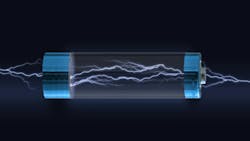Minor Change Boosts Electric-Vehicle and Grid Battery Lifetime by 50%
What you’ll learn:
- Lithium cells now are maiden-charged slowly to maximize their initial capacity.
- Increasing the maiden charging rate trades initial energy capacity for a 50% increase in longevity without altering lithium battery chemistry.
- How lithium ions are transported during charging and discharging, and what happens to those ions during maiden charging.
"We're going to call it now. This research result will be the most disruptive lithium battery development of this decade."—Andy Turudic, Electronic Design Technology Editor and Electrical Engineer
In a study published recently in Joule, researchers at the SLAC-Stanford Battery Center reported that giving battery cells their maiden charge at unusually high currents increased their average lifespan by 50% while decreasing the initial charging time from 10 hours to just 20 minutes. It represents a major coup to both consumers and manufacturers, particularly in the electric-vehicle and grid storage space.
The study was carried out by a SLAC/Stanford team led by Professor Will Chueh in collaboration with researchers from the Toyota Research Institute (TRI), the Massachusetts Institute of Technology, and the University of Washington. It’s the latest in a series of studies funded by TRI with the Department of Energy’s SLAC National Accelerator Laboratory under a Cooperative Research and Development Agreement (CRADA). This lithium-cell research was funded by the Toyota Research Institute through its Accelerated Materials Design and Discovery program.
“This is an excellent example of how SLAC is doing manufacturing science to make critical technologies for the energy transition more affordable,” said Chueh. “We’re solving a real challenge that industry is facing; critically, we partner with industry from the get-go.”
The results from Chueh’s research team have earth-shattering implications for manufacturing of lithium-ion batteries targeting electric vehicles and the electric grid.
“This study is very exciting for us,” said Steven Torrisi, a senior research scientist at TRI who collaborated on the research. “Battery manufacturing is extremely capital-, energy-, and time-intensive. It takes a long time to spin up manufacturing of a new battery, and it’s really difficult to optimize the manufacturing process because there are so many factors involved.”
First-Cycle Lithium Loss Actually Helps Battery Lifetime
To understand what happens during a cell’s initial cycling, Dr. Chueh’s team built pouch cells in which the positive and negative electrodes are surrounded by an electrolyte solution where lithium ions move freely.
During cell charging, lithium ions flow into the negative electrode for storage. When a cell discharges, those lithium ions flow back out and travel to the positive electrode. This triggers a flow of electrons to power devices, from propelling EVs to providing storage, frequency stabilization, and “peaking” for an increasingly renewables-generated electricity grid that could, in time, displace fossil-fuels-based generation entirely.
It’s been well understood that factory-charging a new lithium-ion cell with high currents significantly depletes its lithium supply. As a result, maiden charging is performed at very low currents to avoid energy-storage capacity loss. The discovery here is that NOT doing so prolongs the battery’s life, according to research at the SLAC-Stanford Battery Center.
The depleted lithium has been classically understood to form a protective layer called SEI (solid electrolyte interphase) on the negative electrode. However, the researchers discovered that under fast charging conditions during a cell’s birth, lithium ions are also consumed during side reactions at the negative electrode. This creates additional headspace in both electrodes and helps improve battery performance and lifespan.
“The positive electrode of a newly minted cell is 100% full of lithium,” said Xiao Cui, the lead researcher for the battery informatics team in Chueh’s lab. “Every time the battery goes through a charge-discharge cycle, some of the lithium is deactivated. Minimizing those lithium losses prolongs the battery’s working lifetime.”
“Oddly enough, one way to minimize the overall lithium loss is to deliberately lose a large percentage of the initial supply of lithium during the battery’s first charge,” said Cui. “It’s like making a small investment that yields good returns down the road.”
This first-cycle lithium loss isn’t in vain. The lost lithium becomes part of a squishy layer called the SEI that forms on the surface of the negative electrode during the first charge. In return, the SEI protects the negative electrode from side reactions that would accelerate the lithium loss and degrade the battery faster over time. Getting the SEI just right is so important that the first charge is known as the formation charge.
“Formation is the final step in the manufacturing process,” said Cui, “so if it fails, all the value and effort invested in manufacturing the cell up to that point are wasted.”
High Charging Current Boosts Battery Performance
Manufacturers generally give new cells their first charge with low currents, on the theory that this will create the most robust SEI layer. But there’s a downside: Charging at low currents is time-consuming and costly, and it doesn’t necessarily yield optimal results. So, when recent studies suggested that faster charging with higher currents doesn’t degrade battery performance, it was exciting news.
But researchers wanted to dig deeper. The charging current is just one of dozens of factors that go into the formation of SEI during the first charge. Testing all possible combinations of them in the lab to see which one worked best is an overwhelming task.
To whittle the problem down to manageable size, the research team used scientific machine learning to identify which factors are most important in achieving good results. Just two of them—the temperature and current at which the battery is charged—stood out from all the rest.
Experiments confirmed that charging at high currents has a huge impact, increasing the lifespan of the average test battery by 50%. It also deactivated a much higher percentage of lithium up front—about 30%, compared to 9% with previous methods—but that turned out to have a positive effect. Deactivating more lithium ions during formation frees up headspace in the positive electrode and allows the electrode to cycle in a more efficient way, improving subsequent performance.
“Brute-force optimization by trial-and-error is routine in manufacturing—how should we perform the first charge, and what is the winning combination of factors?,” said Chueh. “Here, we didn’t just want to identify the best recipe for making a good battery; we wanted to understand how and why it works. This understanding is crucial for finding the best balance between battery performance and manufacturing efficiency.”
The cost advantages in lithium-cell manufacturing by decreasing charging time by 97% eliminates one of the two big bottlenecks in such manufacturing. The other, driving off solvents with dry chemistries, has been a tough nut to crack.
Could This Advance be the End for Fossil Fuels?
“Surprisingly, while high-formation charge currents lead to significant side reactions, they also result in up to a 70% increase in cycle life by shifting the electrode-specific utilization range.”—Chueh et al paper’s conclusions
If these researchers’ claims are verifiable (the Scientific Method in play), and if 50% increases in battery life are achievable, this under-our-very-noses discovery could be as significant as the fast-charging research paper early in the last decade. which changed Tesla’s Model S away from its battery-swapping strategy that the car's EV battery was originally designed to do.
With electric cars presently demonstrating 300,000+ miles before seeing 20% degradation in battery capacity since new, we could see 500,000-mile lifetime EVs in a matter of months. This has a huge impact on total cost of ownership and improves resources as well as energy utilization in vehicle creation. Plus, the delayed vehicle “retirement” puts more EVs into service for a given amount of presently constrained annual battery production.
Furthermore, as we roll out grid-storage batteries, CapEx calculations now put wind/solar combined with grid storage at a cost advantage over coal, with predictions of lower cost than methane generation of electricity in a couple of years. With a 50% increase in life for reliable, high-availability, fast-responding, grid-storage battery farms, the nail in the coffin for fossil-fuel electricity generation could be right around the corner purely due to economics—the tree-hugger climate, air-quality, and landfill stuff comes along for a free ride.
We’ll still need oil, but we likely won’t be burning it anymore for electrical power generation or for most mobility applications. We’re seeing a major inflection point about to happen for grid storage and electric-vehicle battery life before our very eyes, and those are usually invisible until everyone looks back in time.
Citation: Cui et al., “Data-driven analysis of battery formation reveals the role of electrode utilization in extending cycle life,” Joule (2024), https://doi.org/10.1016/j.joule.2024.07.024
....with thanks to Dr. William Chueh for providing a pre-press copy for Electronic Design’s review.
Information via SLAC/Stanford
Andy's Nonlinearities blog arrives the first and third Monday of every month. To make sure you don't miss the latest edition, new articles, or breaking news coverage, please subscribe to our Electronic Design Today newsletter.
About the Author
Andy Turudic
Technology Editor, Electronic Design
Andy Turudic is a Technology Editor for Electronic Design Magazine, primarily covering Analog and Mixed-Signal circuits and devices. He holds a Bachelor's in EE from the University of Windsor (Ontario Canada) and has been involved in electronics, semiconductors, and gearhead stuff, for a bit over a half century.
"AndyT" brings his multidisciplinary engineering experience from companies that include National Semiconductor (now Texas Instruments), Altera (Intel), Agere, Zarlink, TriQuint,(now Qorvo), SW Bell (managing a research team at Bellcore, Bell Labs and Rockwell Science Center), Bell-Northern Research, and Northern Telecom and brings publisher employment experience as a paperboy for The Oshawa Times.
After hours, when he's not working on the latest invention to add to his portfolio of 16 issued US patents, he's lending advice and experience to the electric vehicle conversion community from his mountain lair in the Pacific Northwet[sic].
AndyT's engineering blog, "Nonlinearities," publishes the 1st and 3rd monday of each month. Andy's OpEd may appear at other times, with fair warning given by the Vu meter pic.




